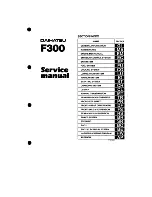
Maintenance Footnotes
† The U.S. Environmental Protection Agency or the
California Air Resources Board has determined that the
failure to perform this maintenance item will not nullify
the emission warranty or limit recall liability prior to
the completion of the vehicle’s useful life. We, however,
urge that all recommended maintenance services be
performed at the indicated intervals and the
maintenance be recorded.
(a) A fluid loss in any vehicle system could indicate a
problem. Have the system inspected and repaired
and the fluid level checked. Add fluid if needed.
(b) Visually inspect wiper blades for wear or cracking.
Replace blade inserts that appear worn or damaged
or that streak or miss areas of the windshield.
(c) Make sure the safety belt reminder light and all your
belts, buckles, latch plates, retractors and anchorages
are working properly. Look for any other loose or
damaged safety belt system parts. If you see anything
that might keep a safety belt system from doing its
job, have it repaired. Have any torn or frayed safety belts
replaced. Also look for any opened or broken airbag
coverings, and have them repaired or replaced.
(The airbag system does not need regular maintenance.)
(d) Lubricate the trunk key lock cylinder. Lubricate all
body door hinges. Lubricate all hinges and latches,
including those for the hood, trunk, console door and
any folding seat hardware. More frequent lubrication
may be required when exposed to a corrosive
environment. Applying silicone grease on weatherstrips
with a clean cloth will make them last longer, seal
better and not stick or squeak.
(e) If you drive regularly under dusty conditions, the
filter may require replacement more often.
(f) Change automatic transmission fluid and filter if the
vehicle is mainly driven under one or more of these
conditions:
− In heavy city traffic where the outside temperature
regularly reaches 90°F (32°C) or higher.
− In hilly or mountainous terrain.
− Uses such as high performance operation.
(g) Drain, flush and refill cooling system. See Engine
Coolant on page 6-20 for what to use. Inspect hoses.
Clean radiator, condenser, pressure cap and filler neck.
Pressure test the cooling system and pressure cap.
(h) If you drive regularly under dusty conditions, inspect
the filter at each engine oil change.
7-7
Summary of Contents for 2005 XLR
Page 5: ...These are some examples of symbols that may be found on the vehicle v ...
Page 6: ... NOTES vi ...
Page 13: ...Put someone on it Get it up to speed Then stop the vehicle The rider doesn t stop 1 7 ...
Page 56: ... NOTES 1 50 ...
Page 112: ... NOTES 2 56 ...
Page 115: ... NOTES 3 3 ...
Page 116: ...Instrument Panel Overview 3 4 ...
Page 159: ...United States shown Canada similar 3 47 ...
Page 194: ... NOTES 3 82 ...
Page 196: ...Overview Navigation System Overview 4 2 ...
Page 272: ... NOTES 4 78 ...
Page 308: ... NOTES 5 36 ...
Page 320: ...Engine Compartment Overview When you open the hood here is what you will see 6 12 ...
Page 394: ... NOTES 6 86 ...
Page 424: ... NOTES 8 14 ...
















































